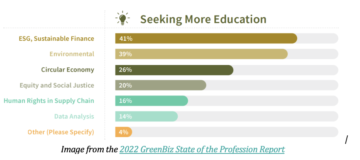
Editor’s note: This is part of a series about how companies can integrate sustainability into their core business strategies. The previous articles in the series describe how to assess your company’s sustainability strategy and how to identify material ESG factors and stakeholders.
In today’s hyperconnected and social media-dominated world, stakeholders of all kinds can have a significant impact on your business success. A tweet from a disgruntled employee, a photograph of problematic labor conditions or a social media campaign by an activist group can go viral overnight. Stakeholders represent a risk to be managed far more proactively and authentically than in the past. But stakeholders also represent an opportunity for improving credibility, reputation, reach, strategic planning and competitive advantage, and for building coalitions to tackle sustainability challenges.
Map and engage stakeholders
A company needs to map the importance and influence of their stakeholders, evaluate what they care about through the lens of ESG and determine how to interact with them on relevant sustainability topics. Assessing stakeholder opinions on material ESG issues can be done as part of developing a materiality matrix or through stand-alone stakeholder outreach and surveys. Once that initial research is done, the company can then assess how best to interact with different stakeholder groups to implement its sustainability goals. For example, a company could collaborate with a stakeholder or just monitor them.
Stakeholder importance differs from influence in that a stakeholder group may be important to the company for its business success but not individually influential. For instance, tomato farmers for a ketchup company are necessary (thus important) to produce ketchup but not influential, while the large retail customer selling the ketchup will be very influential. Internal stakeholder opinions are also important and are reviewed separately from external stakeholder opinions; they show up on two different axes in a materiality matrix.
Stakeholder types
Specific stakeholders vary depending on the industry and company, but there are general categories that are relevant for most.
Employees: While companies say their employee views are important, usually some (leadership of the organization) are treated as more important than others (factory or warehouse workers). In addition to including rank-and-file workers, companies need to expand their outreach to a diverse group of employees to ensure the inclusion of contrary views. Outsourced or offshored employees should be consulted for feedback. The employees of a company’s suppliers and vendors may also be important constituencies, depending on how integral they are to the company’s business (the views of apparel workers in a supplier’s factory are relevant for a branded apparel company).
Stakeholders represent a risk to be managed far more proactively and authentically than in the past.
Investors/Shareholders: For public and private companies, investors are an important constituency. It will be important to segregate types of investors. Institutional investors such as pension funds have a longer-term perspective than hedge funds. Investors with an ESG tilt or impact focus will have different concerns from short-term corporate raiders looking for the company to reduce costs (often in terms of labor). The short-term investors looking for financially engineered short-term results will usually be opposed to more sustainable practices as they see them as a source of cost. On the other hand, most investors, including mainstream banking institutions and passive fund managers such as BlackRock and Vanguard, are beginning to take ESG seriously and build it into their due diligence, credit ratings and investment strategies.
Customers: Just as a business segments its customers to improve service, it should also segment and understand its customers based on ESG considerations. B2B companies must understand their clients’ sustainability commitments. A company can create a competitive advantage by offering products and services that will help clients meet their sustainability commitments as well as reduce its own risk. If a company sells directly to consumers, it should understand how those consumers feel about sustainability. NYU Stern Center for Sustainable Business tracks consumer purchasing of 36 of 40 consumer packaged goods (CPG) categories (250,000-plus products) on a rolling five-year average and has found that sustainability-marketed products have been responsible for 32 percent of the growth in CPG while commanding a 29 percent premium on average.
Suppliers: Conventional supply chain relationships tend to be transactional and aim to optimize financial performance through reducing redundancies and inventory. As companies are increasingly held accountable for ESG issues in their supply chain, they need to deepen their understanding of the material ESG risks for their suppliers and partner to tackle the ESG issues of greatest concern. This may include a careful collaboration among competitors that source from the same supplier. For example, Walmart, Costco and Kroger are all members of the Sustainability Consortium, which issues guidance on how to tackle sustainability challenges for brands and their suppliers.
Vendors: Vendors of non-supply chain-related products such as office supplies or electronics can be important sources of ESG challenges and opportunities as well as partners in addressing them. Vendors may be part of a company’s diversity commitment, for example, or provide low energy-use products.
Competitors: Material ESG issues in your sector will affect your competitors. Understanding shared challenges and opportunities can create the opportunity to collaborate on issues bigger than one company can handle alone, through pre-competitive collaboration.
Industry associations: Many industry associations are tackling ESG issues in their sector by issuing research reports, supporting collaborations and creating industry sustainability standards. They often establish a committee of sustainability leaders from their membership — a useful group for outreach.
Stakeholders also represent an opportunity for improving credibility, reputation, reach, strategic planning and competitive advantage, and for building coalitions to tackle sustainability challenges.
Civil society: Civil society is a large, diverse and important group, where segmentation and engagement will be key for global and regional brands. Depending on the company’s ESG issues, there may be international, national and local environmental and social groups tracking and communicating about the company’s behavior. There will be consumer groups monitoring impacts on their constituents as well as academics studying and writing about corporations and sustainability. In mapping these groups, the company will want to determine who can provide insight into ESG risk or opportunities to partner to solve for a particular sustainability challenge such as child labor.
Media: The media is increasingly eager to cover sustainability issues, usually to catch companies behaving badly, but also to write positive stories about successful solutions and collaborations. In addition to the mainstream media and relevant social media, a growing number of outlets are focused on sustainability, such as Bloomberg Green and Financial Times’ Moral Money.
Regulators: Companies need to keep an eye on local, national and international regulatory trends related to ESG as they evolve rapidly. Identifying key regulators such as the Securities and Exchange Commission and the Department of Agriculture to contact for their feedback on material ESG issues will be critical for strategic planning.
This list may seem overwhelming, especially as you customize it with specific subgroups under each category. Remember, you do not necessarily need to engage or collaborate with all of these groups; rather, your goal is to understand where they stand on the ESG issues material for your success and whether they have insights that might add to, delete or change the prioritization of the ESG issues you have identified. So initially, you are seeking input into your materiality assessment. However, as you develop your sustainability strategy, you will need partners, whether they are employees, suppliers or civil society players. This mapping will help you determine how you would like to interact with key groups.
Engaging with stakeholders can be time-consuming and tough work, but it can also help you manage risk and accelerate progress on your strategy through partnerships. The “Practitioners’ Guide to Embedding Sustainability,” created by the NYU Stern Center for Sustainable Business, offers additional guidance. Our next GreenBiz installment will cover how to incorporate the materiality matrix and stakeholder analysis into your embedded sustainability strategy for maximum impact.
- SEO Powered Content & PR Distribution. Get Amplified Today.
- PlatoData.Network Vertical Generative Ai. Empower Yourself. Access Here.
- PlatoAiStream. Web3 Intelligence. Knowledge Amplified. Access Here.
- PlatoESG. Carbon, CleanTech, Energy, Environment, Solar, Waste Management. Access Here.
- PlatoHealth. Biotech and Clinical Trials Intelligence. Access Here.
- Source: https://www.greenbiz.com/article/engaging-stakeholders-can-help-deliver-sustainability-strategy-create-value-company
- :has
- :is
- :not
- :where
- $UP
- 10
- 250
- 29
- 32
- 36
- 40
- a
- About
- academics
- accelerate
- accountable
- Activist
- add
- addition
- Additional
- addressing
- ADvantage
- affect
- agriculture
- aim
- All
- alone
- also
- among
- an
- analysis
- and
- apparel
- ARE
- articles
- AS
- assess
- Assessing
- assessment
- associations
- authentically
- average
- AXES
- B2B
- badly
- Banking
- based
- BE
- been
- Beginning
- behavior
- BEST
- bigger
- BlackRock
- Bloomberg
- branded
- brands
- build
- Building
- business
- but
- by
- Campaign
- CAN
- care
- careful
- Catch
- categories
- Category
- Center
- chain
- challenge
- challenges
- change
- child
- civil
- clients
- collaborate
- collaboration
- collaborations
- commission
- commitment
- commitments
- committee
- communicating
- Companies
- company
- Company’s
- competitive
- competitors
- Concern
- Concerns
- conditions
- considerations
- consortium
- consumer
- Consumers
- contact
- contrary
- conventional
- Core
- Corporate
- Corporations
- Cost
- Costs
- could
- cover
- cpg
- create
- Create Value
- created
- Creating
- Credibility
- credit
- critical
- customer
- Customers
- customize
- Deepen
- deliver
- Department
- Depending
- describe
- Determine
- develop
- different
- diligence
- directly
- diverse
- Diversity
- do
- done
- due
- each
- eager
- Electronics
- embedded
- embedding
- Employee
- employees
- engage
- engagement
- engaging
- engineered
- ensure
- environmental
- ESG
- especially
- establish
- evaluate
- evolve
- example
- exchange
- Exchange Commission
- Expand
- external
- eye
- factors
- factory
- far
- farmers
- feedback
- feel
- financial
- financial performance
- financially
- Focus
- focused
- For
- found
- from
- fund
- fund managers
- funds
- General
- Global
- Go
- goal
- Goals
- goods
- greatest
- Green
- Group
- Group’s
- Growing
- Growth
- guidance
- guide
- hand
- handle
- Have
- hedge
- Hedge Funds
- Held
- help
- How
- How To
- However
- HTTPS
- hyperconnected
- identified
- identify
- identifying
- if
- Impact
- Impacts
- implement
- importance
- important
- improve
- improving
- in
- include
- Including
- inclusion
- incorporate
- increasingly
- Individually
- industry
- influence
- Influential
- initial
- initially
- input
- insight
- insights
- installment
- instance
- Institutional
- institutional investors
- institutions
- integral
- integrate
- interact
- internal
- International
- into
- inventory
- investment
- Investors
- issues
- issuing
- IT
- ITS
- jpg
- just
- Keep
- Key
- labor
- large
- leaders
- Leadership
- Lens
- like
- List
- local
- looking
- Low
- Mainstream
- mainstream media
- manage
- managed
- Managers
- many
- map
- mapping
- material
- Matrix
- maximum
- May..
- Media
- Meet
- Members
- membership
- might
- money
- Monitor
- monitoring
- moral
- more
- most
- must
- National
- necessarily
- necessary
- Need
- needs
- next
- note
- number
- NYU
- of
- offering
- Offers
- Office
- often
- on
- once
- ONE
- Opinions
- opportunities
- Opportunity
- opposed
- Optimize
- or
- organization
- Other
- Others
- our
- Outlets
- outreach
- overnight
- overwhelming
- own
- packaged
- part
- particular
- partner
- partners
- partnerships
- passive
- past
- pension
- percent
- performance
- perspective
- planning
- plato
- Plato Data Intelligence
- PlatoData
- players
- positive
- practices
- Premium
- previous
- previous articles
- prioritization
- private
- Private Companies
- produce
- Products
- Products and Services
- Progress
- provide
- public
- rapidly
- rather
- ratings
- reach
- reduce
- reducing
- regional
- Regulators
- regulatory
- related
- Relationships
- relevant
- remember
- Reports
- represent
- reputation
- research
- responsible
- Results
- retail
- reviewed
- Risk
- risks
- Rolling
- s
- same
- say
- sector
- Securities
- Securities and Exchange Commission
- see
- seeking
- seem
- segment
- segmentation
- segments
- Selling
- Sells
- separately
- Series
- seriously
- service
- Services
- shared
- short-term
- should
- show
- significant
- So
- Social
- social media
- Society
- Solutions
- SOLVE
- some
- Source
- Sources
- specific
- stakeholder
- stakeholders
- stand
- standards
- Stories
- Strategic
- strategies
- Strategy
- Studying
- success
- successful
- such
- supplier
- suppliers
- supplies
- supply
- supply chain
- Supporting
- Sustainability
- sustainable
- tackle
- tackling
- Take
- terms
- than
- that
- The
- their
- Them
- then
- There.
- These
- they
- this
- those
- Through
- Thus
- time-consuming
- to
- today’s
- Topics
- tough
- Tracking
- transactional
- treated
- Trends
- tweet
- two
- types
- under
- understand
- understanding
- useful
- usually
- value
- Vanguard
- vary
- vendors
- very
- views
- viral
- Walmart
- want
- Warehouse
- WELL
- What
- whether
- which
- while
- WHO
- will
- with
- Work
- workers
- world
- would
- write
- writing
- you
- Your
- zephyrnet











